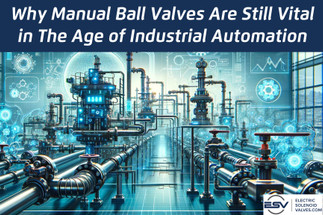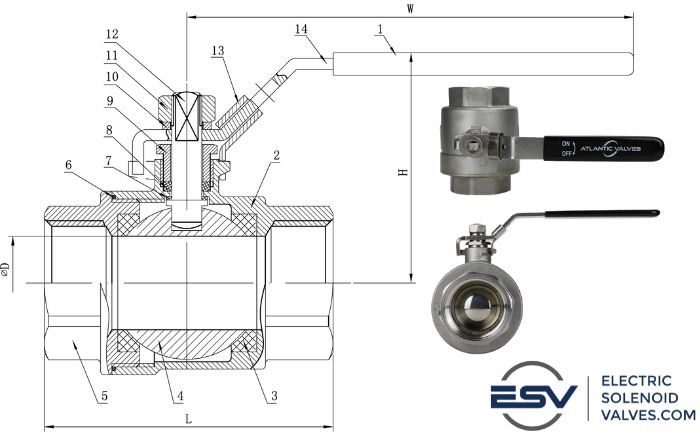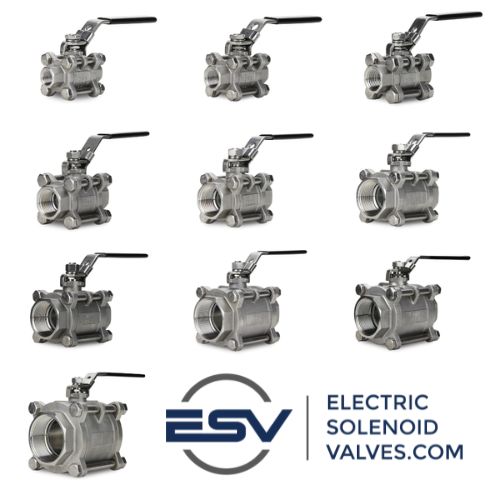Mar 14th 2024
Why Manual Ball Valves Are Still Vital in The Age of Industrial Automation
Industrial fluid applications have undergone several transformations, each improving the reliability, safety and efficiency of fluid-based processes and systems. Automation remains a game changer across different industrial applications. The relevance of automation in fluid applications cuts across precise control, remote system control and management, enhanced maintenance, better system visibility and improved feedback analysis, among other benefits.
Automation in fluid applications continues improving with the inclusion of advanced sensors, sophisticated control systems, advanced valves and flexible flow control designs to accommodate innovations and breakthroughs in Industry 4.0. These innovations have undoubtedly unlocked opportunities and help industries overcome complex fluid control challenges. While these innovations are attractive, manual systems, including manual ball valves, continuously retain immense significance in various fluid flow applications.
Manual ball valves remain the favorite flow control devices in several industrial processes. These valves provide essential flow control, offering unique functionalities in various scenarios and acting as emergency fallback systems in case the prevailing automation systems fail.
This article explores the continued relevance of manual ball valves in different fluid applications. It highlights the strengths of manual ball valves in an industrial system where automation takes precedence and their position in the ever-evolving industrial environments.
Basics and Benefits of Manual Ball Valves
Design and Functionality of Manual Ball Valves
Manual ball valves have a simplified construction with few movable parts. Their straightforward designs are essential for optimizing their functionality and reliability for fluid service. These valves are easy to open and close, making them vital for numerous industrial fluid processes. A manual ball valve contains the following elements:
- Internal Ball - Serves as the primary component to regulate the flow of fluids. The ball has a bore, or hole, running through its center. The rotation of this ball can open or close the fluid flow paths. The ball rests within a valve body containing inlet and outlet ports. The manual ball valve bodies have different end designs, each facilitating easy installation to multiple piping systems.
- Hand Lever and Stem - The hand lever is the structural piece that allows the operators to manipulate the relative position of the ball to achieve desired flow control over time. The hand lever is the actuating mechanism, without which it is impossible to alter the actual position of the ball within the valve body. The hand lever extends beyond the valve body - long enough to facilitate easy movement. The hand lever connects to the ball internally through the stem, made from a suitable material compatible with the chemical and physical characteristics of the fluid media. Turning the hand lever perpendicular to the direction of fluid flow closes the valve, restricting any fluid from flowing. When you turn the hand lever parallel to the fluid flow, the valve opens, allowing fluids to flow freely.
- Seals/Seat Rings - With manual ball valves, like any other flow control devices, preventing fluid leakage at various operational stages is crucial. All manual ball valves have seals that create tight seals as the ball rotates within the valve body. These seals are commonly made of materials like Teflon/PTFE or UMHW Polyethylene.
Advantages of Manual Ball Valves
How does the manual ball valve’s simplified design adapt it for functionality, and how does that affect its functionality in fluid flow control and regulation? Here are a few benefits companies enjoy from utilizing manual ball valves in industrial operations.
- Manual ball valves are reliable. They have few movable parts and are less prone to failures that can lower their long-term performance. The few elements of manual ball valves mean fewer failure points compared to more complex automated valves.
- Manual ball valves have better versatility and can be used for multiple industrial fluid applications.
- Manual ball valves are easy to use and operate. They are designed to utilize the least effort for the quarter-turn motion to initiate or stop fluid flow through a pipe. They also respond fast to changes in flow requirements, offering fluid processes the quick responsiveness required to keep systems running.
Manual ball valves are durable and require fewer maintenance interventions due to their simple designs.
Modern industrial applications still rely heavily on manual ball valves. These fluid control devices work with various automated systems, addressing some gaps in fluid control. They are crucial for enhancing the overall efficiency of manual and automated fluid processes. These valves are predominant in the downstream, midstream and upstream oil and gas operations, chemical processing plants, water and wastewater management plants, power generation systems, food and beverage facilities, and the pharmaceutical industry.
Where to Utilize Manual Ball Valves in Automated Fluid Flow Applications
How do manual ball valves stocked by ElectricSolenoidValves.com maintain relevance despite industries shifting to automated systems? Answering this requires us to understand their distinct roles in fluid flow applications. Manual ball valves remain indispensable as they perform the following functions:
- On/Off Flow Regulation - They can start or stop the flow of different fluids. They are vital for processes where precision is not a top priority. These valves can handle the on/off regulation of viscous service media.
- Isolation and Pipeline Shutoff - Pipeline sections require periodic isolation and shut-off. Pipe isolation is necessary for routine maintenance and repairs or changing critical pipeline equipment. Manual ball valves act as safety devices during such moments and can provide a tight shut-off, for the period when critical maintenance and repair works are ongoing.
Aside from these primary functions, manual ball valves are engineered to provide reliable flow control at elevated pressure and temperature and to perform exceptionally well in corrosive or high-purity environments. They are preferable for high-purity fluid flow operations because they have fewer movable internal parts and are piggable, making cleaning and disinfection easier and faster.
Some conditions necessitating the inclusion of manual ball valves in the design and installation of valves in industrial include:
A Manual Override for Emergencies
There is a factor of safety for each industrial system. When designing flow control systems, engineers ensure they provide a reliable system to avert accidents, should existing automation systems fail. The automated systems may malfunction and fail to achieve the desired fluid control without notice. Installing a manual ball valve provides a means to regulate fluid flow when such malfunctions occur. The manual valves act as failsafe mechanisms, allowing human operators to momentarily isolate pipe sections to prevent uncontrolled fluid flow during emergencies.
Testing And Calibration of Automated Systems
Automated flow control systems undergo testing and calibration to enhance their performance and reliability. When performing calibration, there is a need to dispense service fluids at controlled rates. The manual ball valves provide an effective means to manually regulate flow rates and pressure for accurate and effective calibration of the automated systems. During operations, the manual ball valves help operators implement process adjustments and supplement automated systems to optimize efficiency.
Maintenance Needs
Manual ball valves are vital for pipeline isolation. Their inclusion in system design offers an effective means to stop fluid flow when performing corrective and preventive maintenance on piping systems and equipment. Manual ball valves provide a straightforward means to isolate pipelines with minimal interruption to pipe system configurations.
Modern industrial systems use the most sophisticated technologies and equipment for optimum reliability, safety, and efficiency. However, some fluid properties may restrict the use of automated process valves. In some cases, installing automated process valves may be costly for fluids with particular chemical and physical properties. Manual ball valves can address these shortcomings, allowing industries to manage the flow of chemicals and viscous service fluids more efficiently.
The Role of Manual Ball Valves in Specific Applications
Handling Viscous Fluids and Slurries
Viscous fluids and slurries cause rapid wear and tear of wetted valve components. The abrasive effects of these fluids accelerate when the pressure drop across valves is high. Such conditions make it unsuitable for processes to employ valves with multiple movable internal parts.
When dealing with viscous fluids, especially for pipelines that do not require frequent opening and closing of valves, it may be necessary to utilize manual ball valves. These valves induce minimal pressure drops on piping systems. They also provide excellent flow coefficients, reducing the abrasive effects of viscous fluid and slurries.
Viscous fluids are predominant in upstream oil and gas operations, making manual ball valves preferable choices for extractive and initial production processes. The manual ball valves offer smooth and unobstructed fluid flow paths while maximizing process safety through tight sealing on the valve seats.
Manual ball valves in the Electric Solenoid Valves catalog utilize high-quality manufacturing materials. These materials are adapted to corrosive, high pressure, and temperature environments. Utilizing corrosion-resistant manufacturing materials ensures that manual ball valves can provide reliable long-term fluid service without compromising the safety of processes. They can also resist chemical attacks from the service media for predictable flow regulation amid the complex world of automated fluid flow in industries.
High-Purity Applications
Manual ball valves are handy when handling high-purity industrial applications. These are sensitive industrial processes with high priority for preventing contaminant ingress into processes. Their simple designs and few mechanical parts ensure the valves can perform their intended functions without introducing contaminants from worn-out components into the fluid stream. Such ball valves are essential for food and beverage industries and pharmaceutical processing facilities. They may not be the primary flow control devices but complement the performance and reliability of their automated counterparts.
The reliability of a manual ball valve, like other process valves, depends on their proper sizing. Installing the wrong size of manual ball valve leads to flow inefficiencies, which affect the overall performance of the piping system. Exercise caution when sizing manual ball valves for different industrial processes. Also, consider if the fluid application requires a full-bore or reduced bore manual ball valve.
Important Considerations for Sizing and Selection
Undersizing a manual ball valve creates conditions for restricted fluid flow through the valves. When this happens, the pressure drop across the valves increases, creating conditions for accelerated valve abrasion. The pressure drop due to restricted flow rate can negatively impact the efficiency of the fluid application.
Another precaution when dealing with manual ball valves is the pressure rating of the fluid application. The valve must accommodate the pressure variation across the piping system. Undersizing the manual ball valve leads to undesirable safety and system integrity concerns while oversizing the valves leads to unnecessarily high acquisition and operations costs. When sizing manual ball valves for any industrial application, ensure they match the diameters of adjacent pipes. Well-sized ball valves are essential for optimal fluid flow rates and pressure handling capabilities, vital for maximizing their operational durability.
The Impact of Technology and Innovation on the Future of Manual Ball Valves
How Technology Enhances Manual Ball Valves
The relevance of manual ball valves in a rapidly transitioning automated industrial environment will remain even as innovation and technology take center stage. The emerging technologies are vital for enhancing the performance and functionality of these valves. Some innovations that enhance the functionality of manual ball valves are:
- Use of advanced manufacturing materials and coatings to optimize chemical and physical properties of valves. Advanced materials and coatings can improve valve properties like surface hardness, resistance to chemical corrosion and abrasion resistance. It will allow the use of manual ball valves in different industries, including harsh environments where their functionality is limited.
- Improve seal designs and fabrication material to enhance the sealing efficiency of manual ball valves. Such improvements are critical for optimizing the leak prevention capabilities of manual ball valves. With such innovations, it is easier to utilize manual ball valves to regulate the flow of volatile gases or fluids prone to leakage and fugitive emission from the valve body.
- Enhancing the ergonomic designs of valve handles. Improving minor details on the valve handles significantly impacts operator comfort and enhances the usability of manual ball valves. Ergonomic matters are more prevalent when handling huge manual ball valves, where operators can suffer from fatigue when frequent valve operation is required. An ergonomic valve lever design is vital for enhanced process safety. Another option that can improve the functionality and safety of manual ball valves is the utilization of anti-tamper features on the operating lever. It may include lockable handles for pipelines handling hazardous service media.
Potential Limitations Due to Technology
While technology can improve the performance of manual ball valves, it can also limit its future use in industry. For instance, there are some operations like microchip production where the demand for full automation is required. Other industries demand full process automation as a prerequisite for regulatory authorization. Such stringent requirements and measures may see the phasing out of manual ball valves in some processes and industrial operations.
Another limiting factor for the increased demand for manual ball valves is the increased demand for predictive analytics to optimize proactive maintenance interventions in industries. Manual ball valves may be limited to isolation should companies adopt advanced sensor technology and automated valves for fluid control.
The Enduring Relevance of Manual Ball Valves
With all the innovations and technological changes anticipated, the phase-out of manual ball valves across the fluid control industry is far from actualization. Their demand will continue rising despite the ongoing automation initiatives across the fluid control sector. Manual ball valves are cheaper compared to their automated counterparts. It is vital for low-pressure, low-flow rate fluid applications where the cost effectiveness of automated valves is low. They are also essential for remote operations where power supply and communication infrastructure are unavailable. Overall, manual ball valves are flexible and adaptable, easy to install and maintain and can undergo various modifications to accommodate changes in flow requirements.
Conclusion
Manual ball valves may sound like an old, outdated technology whose time is ending as industries embrace automated fluid control and management solutions. However, these valves continue to prove their significance and supportive role for advanced automated valve solutions. The functionality of these valves will continue improving as the fluid control industry keeps integrating new technologies into processes and products.
Electric Solenoid Valves stocks a wide range of high-quality manual valves to provide long-lasting solutions for your fluid application. Contact our team for technical advice and queries about manual ball valves.




